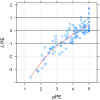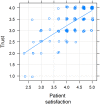The Perception of Physician Empathy by Patients with Inflammatory Bowel Disease
- PMID: 27875561
- PMCID: PMC5119824
- DOI: 10.1371/journal.pone.0167113
The Perception of Physician Empathy by Patients with Inflammatory Bowel Disease
Abstract
Background and aims: This study focused on the difference between perceived and desired physician empathy (pPE and dPE) in the eye of patients with inflammatory bowel disease (IBD). It was investigated if a discrepancy (ΔPE) correlates with trust and satisfaction of patients. At the same time the aim was to gain detailed information about the subjective burden of disease and the resources of IBD patients, in order to better understand them.
Methods: A modified version of the German Version of the Consultation and Relational Empathy (CARE) measure was completed as a paper-and-pencil questionnaire by IBD patients attending our facility (n = 32) and as an online survey by IBD patients at other locations throughout Germany (n = 89). Patients were in average 36.3±12 years old.
Results: The mean (SD) rating of pPE was 3.93 (0.96) on a scale of 1 to 5 ("poor" to "excellent"); however, the mean (SD) dPE was 4.38 (0.48) on the same scale. ΔPE correlated with perceived empathy and with patients' satisfaction with treatment and trust in their health care providers. Patients reported quite a high subjective burden (mean [SD]: 2.93 [.63]) and named family, friends, and support groups as resources.
Conclusions: Rather than assessing patient satisfaction with treatment and trust in their physician only with perceived PE, we suggest ΔPE as a useful additional parameter.
Conflict of interest statement
The authors have declared that no competing interests exist.
Figures









References
-
- Reynolds WJ, Scott B. Do nurses and other professional helpers normally display much empathy? J Adv Nurs. 2000. January;31(1):226–34. - PubMed
MeSH terms
LinkOut - more resources
Full Text Sources
Other Literature Sources
Medical

